MOCA exhibition reveals rich "natural" inspiration
By Hermia Lin Titled "Natural to Next Natural," the exhibition showcases 31 pieces of design works created by 11 groups of Dutch designers and 8 groups of Taiwanese designers. The designers were invited to display their creative talents under five themes—Earth, Aid, Care, Share, and Biotech. The exhibition, which runs until July 20, is organized by the Department of Cultural Affairs of Taipei City. Taiwanese designer Gina Hsu curated the show. World Design Capital in the making. Speaking at the opening ceremony at the MOCA on June 13, Liou Wei-gong, Commissioner of the Department of Cultural Affairs, said he is delighted to see this exhibition taking place in Taipei. Taipei City has been designated the World Design Capital 2016, and the city will focus more on its programs on issues of sustainability and our responsibility for preserving the environment for future generations, he noted. While staff throughout the city government will do their best to push for the realization of the World Design Capital visions, he sincerely welcomes citizens to become more personally involved with design. "'World Design Capital' is not for the government. It is for all citizens and designers. Through the implementation of the programs of World Design Capital in Taipei, we will see how design can make a difference in people's lives, and how it will impact Taiwan society as a whole," the commissioner said. Social designers show their concern for the society and the world, suggesting that human beings should not ignore the importance of protecting nature and caring for the disadvantaged while pursuing convenience and economic growth through design. Taipei and Eindhoven Mayor Hau Lung-bin of Taipei City signed a memorandum of understanding with the city of Eindhoven in 2011. Eindhoven is widely known as a technology city with one of the best talent pools in the world, whose designs serve to inspire and create change. Many Taiwanese designers have chosen the Dutch city as a place to study design. Exhibition curator Gina Hsu lived in Eindhoven as part of an artist-in-residence program in 2013. She said Taiwan and the Netherlands share similar climatic and geographical characteristics. During her stay in Eindhoven, she was inspired and moved by the changes that designs make to the city, and her experience motivated her to put on this exhibition. Every city has its distinctive characteristics in design, she said. Through the exhibition, the curator hopes to share different perspectives and reflections on the society and the environment with viewers. "We can review our lives from new angles and take action to make changes," she suggests. "When we discover the beauty of nature and the value of harmony between people, the world becomes a better place." Natural inspiration In the section on inspiration by "Earth," designers find their muse in Mother Nature. Dutch designers Christoph Brach and Daniera ter Haar extracted pigments from various vegetables and fruits. Through months of careful research and experiment, and without using any chemicals, they drew pigments from pure and mixed vegetables, and applied the natural dyes on different fabrics. The result was 18 unique shades of colors. A series of hand-dyed silk scarves is also on display in the exhibition. Curator Gina Hsu has also contributed her own designs for the exhibition. She worked with Nagaaki Shaw to promote the idea of how to live at peace with nature. The two designers spent some time at the Pearl Community in Yilan, eastern Taiwan. They shared their knowledge of design with the local people and came up the idea of making "bird feeders" using rice straw as the material. In the old days, sparrows would flock in large numbers to the rice paddies, causing endless troubles for farmers. Hsu's idea of making the bird feeder is to promote the concept of coexistence with nature at ease. The bird feeder will be a useful decoration both for people living in the city and those in the countryside. In the "Aid" section, we see designers portraying the suffering and torture caused by war, and some ideas on how to improve their lives after a war. Designer Massoud Hassani used low-cost bamboo and decomposable plastic to create round-shaped land mine scanners. Each land mine scanner is fitted with 175 bamboo sticks, with a plastic attachment stuck to the end of each stick. The round shape of the scanner means it rolls about easily in the wind and detonates any land mine it comes in contact with. This smart design can help decrease the chance of residents being injured by land mines. We are together The "No Country for Old Men—Together" series created by designer Francesca Lanzavecchia and Hunn Wai is one of the highlights in the "Aid" section. The two designers began their cooperation at the Design Academy Eindhoven, where they both graduated with Masters in Design. For this series, they designed furniture and aid devices for the elderly with the goal of improving their quality of life and aesthetic sensibility. Another impressive design was created by Roland Pieter Smit, who has implemented new production systems for the wool industry on a northern island of the Netherlands. His design enables mentally and physically challenged people to participate in the production process. In the "Biotech" section we see four designers from the Wndrlust group who are experimenting with new fabrics based on biotechnology. They promote their concepts and discover new possibilities with new materials and energy. One of the designers, Sonja Baumel, conducted research on the characteristics of human body cells and transformed images of the cells into articles of clothing. The unique garment on display portrays the mystery and beauty of life. Entrance to the exhibition is free.
Staff Writer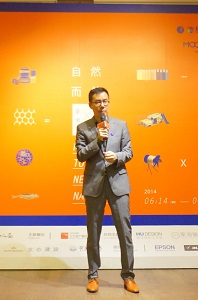 If you're looking for ideas to sharpen your design sensibilities or to know more about how design can be used for the betterment of society, don't miss out on this selection of works from the Netherlands and Taiwan at the Museum of Contemporary Art (MOCA) in Taipei.
If you're looking for ideas to sharpen your design sensibilities or to know more about how design can be used for the betterment of society, don't miss out on this selection of works from the Netherlands and Taiwan at the Museum of Contemporary Art (MOCA) in Taipei.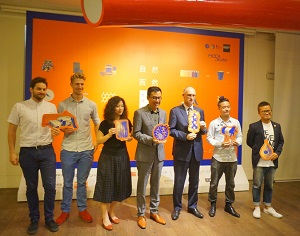 The exhibition is a kick-start for Taipei as the World Design Capital. Through this exhibition the organizers want to introduce the concept of "social design," said Liou. Social design combines commodities and technological invention by making designs that improve the relation between human beings and nature, according to the exhibition brochure.
The exhibition is a kick-start for Taipei as the World Design Capital. Through this exhibition the organizers want to introduce the concept of "social design," said Liou. Social design combines commodities and technological invention by making designs that improve the relation between human beings and nature, according to the exhibition brochure.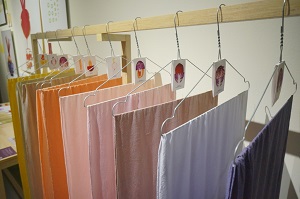 Hsu has vivid memories of the Dutch artists she visited and who befriended her when she was in Eindhoven. Each artist was so sincere and friendly and shared his or her creations piece by piece with her. The works she saw in Eindhoven suggest how designers convey their love for the environment and the third world by making designs that are both useful and beautiful. "The Dutch people and their works have an interesting sense of humor and innocence," she observed.
Hsu has vivid memories of the Dutch artists she visited and who befriended her when she was in Eindhoven. Each artist was so sincere and friendly and shared his or her creations piece by piece with her. The works she saw in Eindhoven suggest how designers convey their love for the environment and the third world by making designs that are both useful and beautiful. "The Dutch people and their works have an interesting sense of humor and innocence," she observed.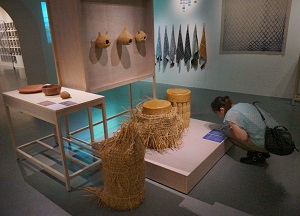 Designers from the Studio Maarten Kolk & Guus Kusters drew their inspiration from the sea. They went to Iceland and took hundreds of photographs of the tidal flow, then transferred the images they captured into different media. The mugs and fabrics on display in the exhibition convey a vibrant sense of life, while the patterns of the designs are sublimely poetic.
Designers from the Studio Maarten Kolk & Guus Kusters drew their inspiration from the sea. They went to Iceland and took hundreds of photographs of the tidal flow, then transferred the images they captured into different media. The mugs and fabrics on display in the exhibition convey a vibrant sense of life, while the patterns of the designs are sublimely poetic.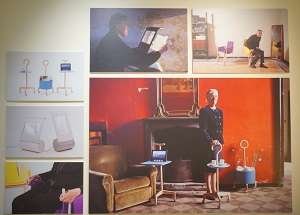 They created several specially-designed walking aids, the T-cane, U-cane, and I-cane, which allow the elderly to move around easily while carrying magazines or mobile devices at the same time. The T-cane is designed to allow users to carry a tea tray while moving around with the stick. The U-cane can be used as a magazine holder or a knitting basket, while the I-cane can be used as an iPad holder.
They created several specially-designed walking aids, the T-cane, U-cane, and I-cane, which allow the elderly to move around easily while carrying magazines or mobile devices at the same time. The T-cane is designed to allow users to carry a tea tray while moving around with the stick. The U-cane can be used as a magazine holder or a knitting basket, while the I-cane can be used as an iPad holder.

![Taiwan.gov.tw [ open a new window]](/images/egov.png)
